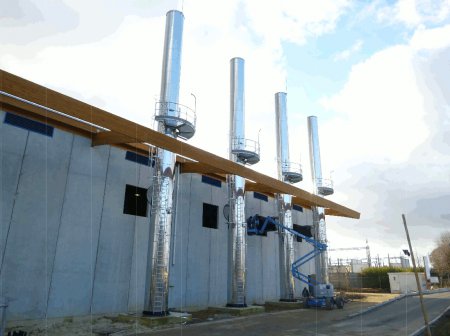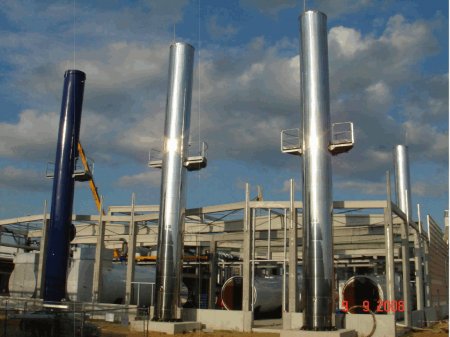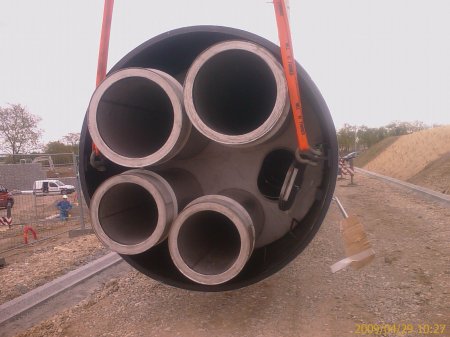-
Chimneys
Creation date: 27th of September. 2012
Definition
A chimney is a conduit able to convey the hot combustion gases and pollutants to atmosphere in the safest conditions for environment and human health.
Function
A industrial stack performs the following functions :
- to convey the combustion gases and pollutants (NOx, CO2, SO2, heavy metals, water steam, dust,..) from process outlet at ground level to atmosphere at a highest level,
- to protect the environment and the human beings by rejecting the plume of smoke and pollutants at sufficient height that prevents too rapid drops on the ground and high concentration of pollutants on a limited area (the height of the chimney is computed based on the mass of sulphur dioxide emitted and the height of buildings in the vicinity. The minimum height shall be at least 3m above roof level of the factory building or 15m measured from ground level whichever is the higher),
- automatic measurement of targeted pollutants (opacimeters: measurement of dust in the flue gas) according to local regulations and norms.
Main components
A chimney includes generally :
- the barrel of the stack (made of carbon steel, corten steel, stainless steel, or exotic alloy metals to deal with any flue gas condition) composed of a single or double wall depending on the level of stress applied (wind, earthquake), fit with access door and traps, its anchoring foundation plate and rain protection cover of anchoring rods. Several gas exhausts (mutiple-conduit stack) can be placed inside the same outer wall. The inner wall is subjected to thermal stresses - the outer wall is subjected to mechanical stresses.
- the anchoring ring to be cast in the concrete and welded to reinforcement bars of concrete basement.
- the outer (mono-conduit) insulation of the conduit (needed in most cases for decreasing heat losses and improving the draft of chimney).
- the metal sheets (corten steel, stainless steel, aluminium) of outer cladding that protect the outer insulation material (single wall).
- the access ladders (mandatory when the chimney is higher than 30 meters and in the case where instrumentation is installed above ground level) and resting gateways.
- the wind damping device (it allows to reduce the strenghts caused by the wind and to avoid any detrimental vibrating mode of the stack).
- the instrumentation: temperature transmitter, flue gas opacity transmitter.
- the regulatory color bands to be installed on top of the chimney (when required by regulation) and in some particular cases the night signal lights (required on tall chimneys or in case of presence of a nearby airport).

In line metallic chimneys
Photograph published by courtesy of Union Thermique, reproduction prohibited.
Different types
There are two main types of chimneys, depending on size of installation and flow of exhaust flue gas.
Steel chimneys
- Autostable chimney
A autostable chimney is fixed only on its foundation base.

Three metallic autostable chimneys
Photograph published by courtesy of Union Thermique, reproduction prohibited

Detail of a chimney head with multiple outlet conduits
Photograph published by courtesy of Union Thermique, reproduction prohibited.
- Chimney hooked to an intermediate point
The median rigging allows to reduce the bending moment transmitted to the slab support
- Cable stayed chimney
Cable stayed chimneys are an economical solution because the stays fixed to the ground allow to reduce the thickness of the shaft of the chimney and the volume of the slab support.
Concrete chimneys
When the height of the chimney is too high, it is no longer possible to use a single-wall steel stack because the important boom at the top level, owing to bending moment, would cause a stall of outside insulation cladding plates. It is therefore necessary to build a chimney with double wall: the inner wall is subjected to thermal stresses - the outer wall is subjected to mechanical stresses. When the height becomes even greater (150 m), it becomes more economical to build a concrete chimney.

Tallest concrete chimney in Europe (360m)
Trbovlje coal power plant
Unknown ownership and copyrights for this photographThe 360 m (1,200 ft) high chimney of the Trbovlje coal power plant on the shore of the river Sava near Trbovlje, Slovenia was poured in 210 days, and required 11,866m³ of concrete and 1,079 tons of reinforcing steel. A high chimney was required for the site to ensure that emissions were removed from the deep, narrow valley under all weather conditions. The plant is operated by Termoelektrarna Trbovlje d.o.o. and became operational in 1966.
Concrete chimney inner wall is most currently covered with a lining which may perform the following functions:
- protection against acid corrosion,
- reduction of heat losses along the duct and improvement of the draft.
The existing types of protective lining materials are:
- Fiberglass reinforced plastic (FRP),
- C-276 and other high nickel alloys both solid and clad,
- Acid resistant brick and mortar,
- Carbon steel Stainless steel,
- Gunite linings,
- Refractory linings
- Borosilicate glass block linings,
- Vinylester coatings,
Links
International Comittee of Industrial Chimney (CECIND)

